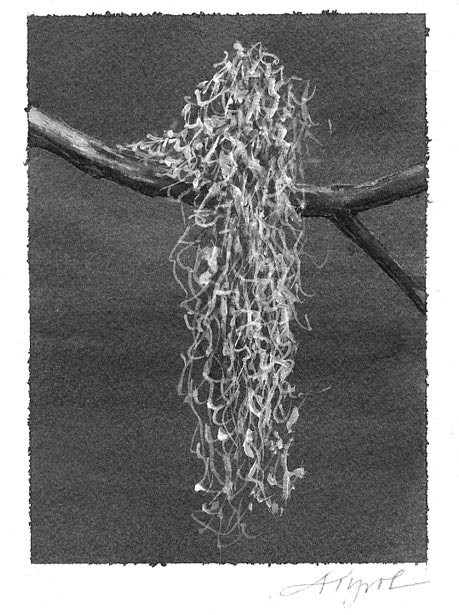
Usnea, pronounced ooze-nee-ah and better known as old man’s beard, is the long, lacy, greenish lichen that grows from tree trunks and branches in forests across New Hampshire and Vermont. It is considered by some to be one of nature’s most effective medicinals, by others as an excellent gauge of environmental pollution, and by still others as an indicator of true north. That is, if it’s taken into consideration at all. Most people seem never to have heard of it.
My own introduction to Usnea came during a mushrooming workshop a few years ago in Vermont’s Groton State Forest. Since it was after the first frosts of autumn and not too many mushrooms were still visible, the instructor pointed out all kinds of other interesting things, including a handful of green lichen dangling from a dead conifer “This here is Usnea, excellent for bacterial and fungal infections. It’s stronger than penicillin.”
I tend to prefer natural remedies over conventional pharmaceuticals, so my ears perked up. The first thing I learned is that Usnea isn’t a plant, not in the traditional biological sense. Rather, it is classified as a fungus. Like a botanical mermaid, Usnea is a combination of two organisms, a fungus and an alga – two completely different life forms that come together in a delicate balance to grow in symbiotic union, creating a new specific structure. For habitat, Usnea prefers old or dead conifers and deciduous trees in a moist forest.
The way to distinguish Usnea from other lichens that need similar environments is to hold a strand in your fingers and gently tug on either end. The outer green sheath will split, revealing a white inner pith that will stretch before snapping. Usnea is elastic; other lichens aren’t.
This remarkable non-plant was used therapeutically over 3,000 years ago in Egypt, Greece, and China to treat bacterial and fungal infections. Today, it is still used by Asian and Russian herbalists to treat pulmonary tuberculosis, bronchitis, infected wounds, external ulcers, and scrofula. Native North Americans have used it as an expectorant and a dermatological aid for boils. Outdoorsmen know it as a superbly absorbent emergency dressing for backwoods wounds. Proponents of alternative medicine claim that Usnea is useful for treating the common cold, sore throats, and coughs. Recent laboratory studies have even suggested an anti-cancer use for Usnea.
What I found most interesting, though, is that Usnea not only has alleged medicinal properties but also acts as an extremely sensitive filter, and therefore barometer, of pollution. Heavy metals are particularly likely to accumulate in Usnea, and the lichen is very susceptible to damage from sulfur dioxide and acid rain, both the result of burning fossil fuels.
If you decide to harvest some Usnea for its botanical properties, therefore, it is best to stay away from busy roadsides and heavily populated areas where pollution is heaviest. On the positive side, if you come across a forest with lots of healthy Usnea growing from the trunks and limbs, you can be sure you’re in a relatively clean environment. (The reverse, of course, is not necessarily true – a lack of Usnea may simply be the result of a habitat that is too dry and sunny, not too polluted.)
Given the right conditions, Usnea grows worldwide, except in Australia. I once took a trip to Uruguay and saw miles upon miles of wooden post fencing draped with the beautiful tendrils. It is becoming less common to see Usnea in western Europe, where lichens in general are on the decline because of pollution and the depletion of suitable forest habitat. In Germany, Usnea now has protected status.
As for its final use – as an indicator of which way north is – you should proceed with caution. Despite the old saying that “moss grows on the north side of trees,” Usnea grows on the moist sides of trees, given that its primary source of moisture is from the air. In open, deciduous forests, this is most likely to be the shaded, north side. But in closed-canopy forests that hold moisture well, Usnea may grow on all sides of the trees. If some other natural feature is in play, such as a steep hillside that blocks morning light while allowing afternoon sun to reach the trunks, Usnea may grow on the shadier, east side of the tree.
With its lacy fronds hanging down from trunks and branches, Usnea resembles an upside-down version of underwater coral, another vulnerable barometer of pollution worldwide. Next time you find yourself in the forest, keep an eye out for Usnea. As long as it is growing and healthy, our local forests should be, too.


Discussion *